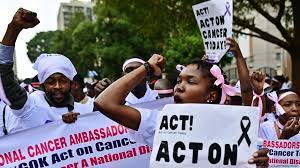Miriam Mutebi
Noncommunicable diseases, such as cardiovascular disease, cancer, diabetes and obesity, kill 41 million people per year, with 77 percent of these deaths occurring in low- and middle-income countries. In sub-Saharan Africa, noncommunicable diseases are now responsible for about 37 percent of deaths – up from 24 percent in 2000. Cancer is one of the top three diseases driving this increase, accounting for more than half a million deaths in 2020. And this number is expected to double by 2030 if the status quo is maintained.
As with other noncommunicable diseases, many cases of cancer could be prevented by addressing behavioral risk factors, such as tobacco and alcohol use and obesity, which contribute to more than 40 percent of all cancer deaths worldwide. Other cost-efficient measures include widespread vaccination against the human papillomavirus, which causes most cervical cancers, and against hepatitis B, which, along with hepatitis C, contributes to liver cancer. In Africa, cancers associated with infections accounted for about 27 percent of all cancers in 2018 – the highest of any region monitored by the World Health Organization.
Furthermore, many common cancers, such as colorectal, breast, prostate and cervical cancer, can now be treated successfully if detected early. But they remain among the deadliest in Africa, because patients there are typically diagnosed too late with advanced disease and frequently do not complete their care. There are multiple reasons for this, including a combination of financial, health system and sociocultural barriers, as well as chronic underfunding that impedes the ability of African public health agencies to provide timely, value-based quality care. Many African countries also lack the resources, infrastructure and workforce needed to implement effective vaccination and population screening programs. And, despite improvements over the last few years, many countries do not have access to safe and timely diagnostic and treatment services.
Regional disparities are another major concern, as many cancer patients must travel long distances to reach treatment centers, which are generally located in urban areas. The need to find accommodation and manage work or childcare concerns can deter many patients from completing routine screenings or treatment, while out-of-pocket costs for screening services, where available, also tend to limit their routine uptake. Even when care is available, social and cultural norms may prevent people from seeking it. For example, social stigma often discourages many patients suffering from cancers affecting sexual and reproductive organs. Similarly, “cancer fatalism” leads many to believe that the diagnosis is a death sentence and that treatment is futile. “Collectivism,” whereby the community decides about a patient’s ability to access care, also ultimately results in poorer outcomes.
Consequently, cancer survival rates in low- and middle-income countries are abysmally low compared to high-income countries. For example, while the five-year survival rate for breast cancer in richer countries is above 84 percent, it drops to 40 to 60 percent in low- and middle-income countries. Survival rates for colorectal cancer, which can reach 76 percent in high-income settings, are lower than 25 percent in low-income countries. And, owing to low HPV vaccination rates and the lack of effective testing, low- and middle-income countries account for 90 percent of all cervical cancer deaths, underscoring the need for urgent action. A recent Lancet Oncology Commission report on cancer in sub-Saharan Africa that I co-authored emphasizes the need for African governments to invest in local data collection and research to support and develop resource-efficient cancer detection and treatment programs tailored to their countries’ specific needs and funding requirements. We also recommend that governments start to think of innovative ways to expand universal healthcare coverage to include cancer services such as early diagnosis, targeted treatments and supportive care.
Kenya, Nigeria and other African countries are already moving ahead with initiatives to expand access. By mobilizing international support and engaging local stakeholders, these countries could invest in prevention and early detection strategies, including mobile screening units, community outreach programs, self-examination kits, in vitro diagnostics, and telehealth, thus improving prevention and early detection. But diagnosis is not enough. System preparedness is essential and the infrastructure and skilled workforce to provide treatment for detected cancers must be expanded in tandem with any early diagnosis.
Moreover, to ensure equal access to health services, African countries should train primary care physicians to identify the early signs of cancer and facilitate timely referrals. A patient in sub-Saharan Africa sees four to six healthcare providers, on average, before a cancer diagnosis is made. Governments should also integrate resources meant for COVID-19, HIV/AIDS and other infectious diseases toward comprehensive strategies – for example, providing cervical cancer screening for patients with HIV. While integrated clinics capable of treating both infectious diseases and noncommunicable diseases would be ideal, policymakers must be pragmatic and consider the shortage of healthcare personnel, particularly in densely populated areas, and develop models and innovations that can help bridge some of these access barriers.
Countries such as India, Pakistan and Jordan have shown that investing in building local capacity makes developing world-class cancer facilities possible, despite limited resources. African policymakers, too, are increasingly aware of the need for local cancer detection and treatment capacity, as evidenced by an increase in the number of countries with national cancer-control programs and the expansion of oncology training centers and infrastructure for care. Rwanda, where a widespread HPV vaccination program and expanded testing could make the country one of the world’s first to eliminate cervical cancer, also provides a useful model for improving health outcomes in low-resource settings. Given this continent-wide trend, we have a unique opportunity to enhance our regional collaboration and develop centers of excellence for knowledge-sharing, research and coordinated, evidence-based treatments for patients. But to realize the promise of recent advances in diagnostics and care, from vaccines and immunotherapy to precision medicine and multi-cancer early detection tests, we must ensure that the basics of cancer care are readily available and that life-saving treatments are distributed equitably. To paraphrase the activist and U2 co-founder Bono, where you live should not determine whether you get to live.
Arab News







